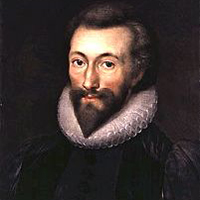A Valediction: Forbidding Mourning by John Donne: Summary and Analysis
A very well-known poem, A Valediction: Forbidding Mourning is a metaphysical love poem by John Donne written in 1611 or 1612 and published in 1633 in the collection of 'Songs and Sonnets'.

John Donne (1572-1631)
This poem was written to his mistress when John Donne takes leave for the tour to Continental Europe for a comparatively a long time. As a master of using extended metaphor, he has used the image of compass here as a conceit.
In the opening of the poem, the speaker, in a dramatic situation, addresses his beloved not to make their separation time the occasion of mourning and wailing. The tearful parting may be disrespectful to their true love. As the virtuous men die silently and without any complaint, they should also take a peaceful leave as their love is also virtuous one. The speaker goes on counseling her saying when the earth moves (earthquake), everything on the earth are shaken and brings a great deal of fear, but the heavenly bodies and the universe remain calm and innocent, untouched by the temporary movement of the earth. In the same manner, she too has to be calm and fearless as this separation is for the time being and their love is above all these earthly things like “eyes, lips, and hands” which they are not going to miss at all.
The speaker shows the fact that though he has to go and their bodies are far from each other, their souls are one. There will not be a gap, but an expansion of the love. The speaker gives here and analogy of gold. The gold can be stretched and expanded by thinning it and their love will also expand and travel all the space between them and unite them in souls. And in next extended metaphor (conceit), he compares their souls to the compass where her soul is the fixed feet in the center of the compass and his soul is the foot that moves around the compass. However, far the moving feet of the compass go, it remains attached and connected to the center foot of the compass. Though, the speaker is going to be physically parted, his soul will always be in touch with his beloved. The stronger, she will be at the time of separation, the more his work will be fruitful. He firmly says that he has to end his tour one day from where he has begun, means he will certainly come back to see her again.
The intensity of feelings of separation is overloaded in this poem which was written to his wife Anne before taking leave for the continental Europe tour. The conceit of Compass is outstanding in this poem which is often cited in English literature as one of the best examples of extended metaphor. Some critic takes it as ‘the best known sustained conceit’. His precision of wording in this poem is praise worthy. The poet depicts the fear of separation of the lovers and at the same time by the end of the poem he praises the beauty of love and their connected souls.
This poem is composed up of nine stanzas containing four lines in each stanza. This poem creates a contrast between the common love of the general people and the unique love of the speaker. He separates his love from others in a way that their love does not whine and show any fear of separation when they part from each other because they are not only connected in terms of physicality but in souls. They are like compass where his beloved is a fixed foot in the center and the speaker is the moving feet of the compass which moves around but connected to the center. This famous and ingenious use of the compass as a conceit is exceptional.
Cite this Page: MLA Style
Shrestha, Roma. "A Valediction: Forbidding Mourning by John Donne: Summary and Analysis." BachelorandMaster, 6 Mar. 2018, bachelorandmaster.com/britishandamericanpoetry/a-valediction-forbidding-mourning-summary-analysis.html.
Related Topics
 |
bachelorandmaster.com |